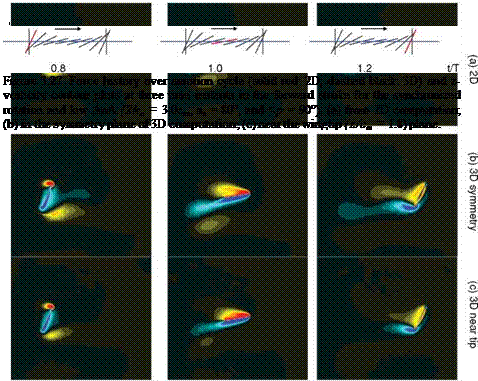Region of Similarity: 2D versus 3D
There are interesting combinations of wing kinematics that result in similar lift in both 2D and 3D. For some cases, even the instantaneous forces agree well.
Figure 3.27 shows the flow fields of such a case corresponding to these kinematic parameters: 2ha = 3.0cm, aa = 80°, and у = 90° at t/T = 0.8, 1.0, and 1.2. The variation along the spanwise direction is modest, making the 2D and 3D simulations substantially similar. The 2D flow field and the corresponding 3D flow on the symmetry plane are strikingly consistent. The high angular amplitudes lead to low AoAs
Figure 3.26. Force history (2D: red, 3D: black) for a motion cycle and z-vorticity contour plots at three time instants in the forward stroke for the delayed rotation and low AoA (2ha = 4.0cm, aa = 80°, and <p = 60°): (a) from 2D computation; (b) in the symmetry plane of 3D computation; (c) near the wingtip (z/c = 1.8) plane.
 |
and, coupled with the timing of the rotation, lead to a flow that does not experience delayed stall, because the formation of LEVs is not promoted. The timing of the rotation for this example puts the flat plate at its minimum AoA (10°) at the moment of maximum translational velocity, while the translational velocity is zero when the flat plate is vertical. It is seen from the flow field that both the TiV and the LE/TE vortex formation are largely suppressed. The net effect is a fairly uniform spanwise lift distribution, closely resembling the 2D case with the same kinematics.
Neither the 2D nor 3D results in this case promote downward induced jet formation. As summarized in Figure 3.27, the 2D and 3D lift coefficients are similar in the instantaneous and time-averaged senses. One implication of this similarity is the usefulness of the 2D simulation for generating quantitative data on a 3D counterpart. However, not all cases in this region display this similar instantaneous behavior, and sometimes the time-averaged lift similarity results from the partial canceling out of different features.













